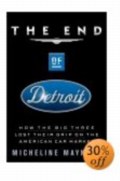Book
Reviews:
The End of Detroit:
 Michelle
Maynard, The
End of Detroit: How the Big Three Lost Their Grip
on the American Car Market (New York; Doubleday; 2003)
; $24.95; 314 pps.
Michelle
Maynard, The
End of Detroit: How the Big Three Lost Their Grip
on the American Car Market (New York; Doubleday; 2003)
; $24.95; 314 pps.
Reviewed
by Jamie Smiles (Mr. Smiles is the auto analyst
for Aladdin Capital Management LLC in Stamford, Connecticut).
 Click
here to purchase Michelle
Maynard’s book, The End of Detroit: How
the Big Three Lost Their Grip on the American
Car Market (New York; Doubleday; 2003) ; $24.95;
314 pps.
Click
here to purchase Michelle
Maynard’s book, The End of Detroit: How
the Big Three Lost Their Grip on the American
Car Market (New York; Doubleday; 2003) ; $24.95;
314 pps.
Michell
Maynard’s The End of Detroit is an account
of the American loss of market share to Japanese and German
automakers. The author is a reporter for the New York Times,
who follows the airline and automobile industries. She
has also written for Fortune, USA TODAY, Newsday, and U.S.
News & World Report. Her book argues that GM, Ford,
and Chrysler have lost their influence over American consumers
because of a lack of quality, misunderstanding of customer
needs, and a high cost structure. Ms. Maynard documents
how Toyota and Honda grew from offering cheap, energy efficient
cars in the 1970s to becoming full-line automobile manufacturers.
Her writing style is readable, yet it lacks in-depth research
as it pertains to the US automakers. Maynard may be correct
in attributing significant market share losses to US hubris,
but she fails to recognize Detroit’s history of financial
and industrial innovation. The End of Detroit is a worthwhile
read, but Ms. Maynard’s strong anti-US bias is underscored
by the books title, and makes any reader question her objectivity.
Maynard’s anti-domestic bias is not subtle, and it detracts from
the overall enjoyment of the book. She invites reader skepticism by mentioning
that BMW's CEO served her chocolate cake and champagne in his hotel room,
and that Japan's Big Three granted her top management interviews (in the
case of Toyota, both CEO and COO, as well as top US officers). She criticizes
Detroit as being unresponsive to globalization and changing trends, and
presents a stark picture of the culture of arrogance and insularity that
led American car manufacturers astray. Nor does she give any credit to
prior American industrial or financial innovation.
Ms. Maynard’s case would have been bolstered had she focused more
on the importance of legacy costs such as pension and health care retirement
benefits and how these high costs are making the US uncompetitive. Recently,
Gary Laepidus, a Goldman II ranked analyst was quoted as saying, “there
is more health expense in an automobile than there is steel.” By
not spending more time focusing on crucial non-operating expenses such
as health care and pensions, Ms. Maynard detracts from the importance of
the subject.
On the positive side, Ms. Maynard’s book does provide an overview
of the last two decades, commenting on which vehicles have been top sellers
and why. Her journalistic style makes it easy to track the transition from
larger, gas-guzzling automobiles in the ‘70’s to the more energy
efficient, compact cars of the mid-to-late eighties. It also provides other
interesting facts. For instance, foreign-owned companies have built 17
plants in the United States and currently employ 85,000 people to produce
cars and trucks many Americans assume to be "imports."
That the US has been losing market share for the last 10 years is a well-known
fact. According to Ward’s Automotive, the US market share for the
Big 3 in 1980 was 73%, vs. 57% last September. There is no denying that
loss of market share is a serious issue for the US automobile manufacturers.
The growing number of vehicles sold in the US, however, has significantly
mitigated its effect on the Big 3’s profitability. In 2002, there
were 15.8mm cars sold in the US, far more than the 9.8mm that were sold
in 1980. Analysts are expecting 16.8mm in ’03 and 17.2mm in ’04.
Also, Ms. Maynard does not mention the awesome cash cushion the Big 3 have
amassed in case the US faces a difficult recession. Combined, the Big 3
have on balance sheet cash positions of more than $35B, enabling them to
endure several years of operating losses in excess of those experienced
in the ‘90-91 recession.
Ms. Maynard provides impressive examples of Japanese innovation, but fails
to mention past US successes. Toyota, for example, built car plants in
the U.S. and trained local employees, including Spanish-speaking workers,
who would later be able to work in Toyota plants in Mexico, South America
and elsewhere. Yet there is no comment on the introduction of the SUV or
the advent of the Ford Taurus, two important US innovations. Someone needs
to remind Ms. Maynard that within two and half years of its introduction,
the Taurus was the US’s best-selling vehicle and brought record profitability
to the Ford Corporation. Also, the introduction of the minivan and the
SUV revitalized the industry, leading to continued American dominance.
Many insiders believe the real battle in the future will revolve around
technological innovation, and Ms. Maynard’s failure to cover this
topic is a disappointment. Hybrids, electronic and fuel-efficient cars
will be the key to winning future battles in Detroit, especially if the
price of gasoline climbs above $2 a gallon. The players who can fully understand
and exploit their full potential hold the key to long-term survival in
the new paradigm. For this important future battle, Detroit is positioned
well.
Her book does serve as an important reminder that American car manufacturers
have seen their market share erode due to a ceaseless flood of import vehicles,
mostly from Japan, Germany, and South Korea. At first, the Big 3 ignored
the competitors, as they operated in what Detroit considered fringe markets
(e.g. low-cost, high fuel mileage compacts and high end luxury models).
The Big 3 mistakenly maintained a firm hold on the cars they considered
most important, specifically the gas guzzling, V-8 powered, family car.
But, Detroit has responded, announcing major restructurings that are likely
to result in improved financial performance.
Maynard begrudgingly admits that there is still hope for American auto
companies, but she refuses to discuss possibilities for American improvement.
In the wake of 9/11 and unparalleled patriotic feelings, US consumers are
likely to respond positively to reliable and inexpensive American products.
The Big 3 have generated particularly strong loyalty among US construction
workers. Building or renovation sites are full of GMC, FORD, and Dodge
trucks, and US “light trucks” are generally considered to be
more reliable than Asian imports. Importantly, these light trucks tend
to be more profitable than regular cars, providing a benefit to Detroit’s
profitability.
The End of Detroit is a worthwhile read for anyone who follows the auto
industry closely. It is concise, journalistic, and full of amusing anecdotes.
Unfortunately, Ms. Maynard’s anti-US bias is fully apparent, and
her title choice immediately calls into question her objectivity. Indeed
the US auto industry is challenged on many fronts. Its cost structure is
far higher than its international competitors; non-operating costs, including
pension and health expenses have grown rapidly; and a dearth of new products
has resulted in a loss of market share. But the big three have faced adversity
before, and foreign dominance in the US car market is not a foregone conclusion.
Her method of extrapolating current conditions and predicting a financial
restructuring by at least one of the Big 3 is naïve. US carmakers
realize that regaining their customers will be a struggle, but they appear
up to the challenge. In fact, it is quite possible that readers will look
back on the publication date of this book with amusement. Since the publication
of her book, the share prices Ford and GM have risen by 17% and 14% respectively,
in anticipation of an improved earnings profile and innovative products.



